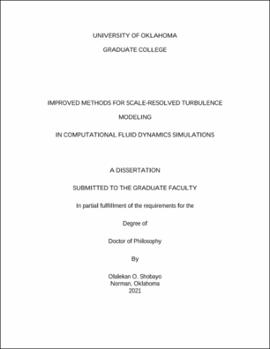| dc.contributor.advisor | Walters, Dibbon Keith | |
| dc.contributor.author | Shobayo, Olalekan Olubunmi | |
| dc.date.accessioned | 2021-11-09T14:11:50Z | |
| dc.date.available | 2021-11-09T14:11:50Z | |
| dc.date.issued | 2021-10-27 | |
| dc.identifier.uri | https://hdl.handle.net/11244/331233 | |
| dc.description.abstract | The present study presents improved methods for modeling turbulent fluid flow and heat transfer within the context of computational fluid dynamics (CFD) simulations. Specifically, the study proposes and investigates two novel methods for improved turbulent flow simulation. The first is an improved method for blending the Reynolds-averaged Navier-Stokes (RANS) and large-eddy simulation (LES) components within the dynamic hybrid RANS-LES (DHRL) modeling framework. The objective is to improve the performance of the DHRL model for prediction of turbulent heat transfer for cases in which the mean velocity and mean temperature gradients are not well aligned. Analysis of the current baseline version of DHRL shows that significant error can arise in such a situation, and the new method is specifically designed to address this shortcoming. The second new contribution is a method for generating synthetic turbulence to provide initial and/or boundary conditions in scale-resolving CFD simulations that adopt either an LES or hybrid RANS-LES modeling approach. Each of these methods is investigated for canonical flow test cases which are intended to highlight their potential strengths and weaknesses. The results of these investigations are presented in a series of chapters that correspond to published or submitted manuscripts, each of which focuses on one particular aspect of the overall research plan.
In order to investigate the newly proposed DHRL blending function, simulations are performed for an idealized fully-developed planar channel flow case for which the mean velocity gradient is non-zero only in the wall-normal direction, and the mean temperature gradient is imposed to be uniform and non-zero in the streamwise or spanwise direction. Turbulent heat flux predictions are obtained for three different classes of modeling approach: Reynolds-averaged Navier-Stokes (RANS), large-eddy simulation (LES), and hybrid RANS-LES. Results are compared to available DNS data at Prandtl number of 0.71 and Reynolds number of 180 based on friction velocity and channel half-width. Specific models evaluated are the k-w SST RANS model, monotonically integrated LES (MILES), delayed detached eddy simulation (DDES), improved delayed detached eddy simulation (IDDES), and dynamic hybrid RANS-LES (DHRL). The DHRL model includes both the standard formulation that has been previously documented in the literature as well as the new modified version developed specifically to improve predictive capability for flows in which the primary mean velocity and mean temperature gradients are not closely aligned. The modification consists of using separate RANS-to-LES blending parameters in the momentum and energy equations. Results are interrogated to evaluate the performance of the three different model types and specifically to evaluate the performance of the new modified DHRL variant compared with the baseline version. Overall, the modified variant of DHRL, relative to IDDES, DDES and baseline DHRL (hybrid RANS-LES models) showed improved performance in predicting turbulent heat flux both in streamwise and spanwise directions.
The new proposed method for synthetic turbulence generation—denoted as statistically targeted forcing (STF)—seeks to introduce a fluctuating velocity field with a distribution of first and second moments that match a user-specified target mean velocity and Reynolds stress tensor, by incorporating deterministic time-dependent forcing terms into the momentum equation for the resolved flow. The STF method is formulated to extend the applicability of previously documented methods and provide flexibility in regions where synthetic turbulence needs to be generated or damped, for use in engineering level large-eddy and hybrid large-eddy/Reynolds-averaged Navier-Stokes CFD simulations. The performance of the proposed STF method is evaluated in LES simulations of isotropic and anisotropic homogeneous turbulent flow, spatially-developing freestream turbulence, and temporally-developing mixing layer test cases. Results are interrogated and compared to target statistical velocity and turbulent stress distributions and evaluated in terms of energy spectra. Analysis of the influence of STF model parameters, mesh resolution, and LES subgrid stress model on the results is investigated. Overall, results show that the new STF method can successfully reproduce desired target statistical distributions, reproduces spectral energy distributions consistent with the known characteristics of three-dimensional turbulence, and allows control of the characteristic integral length scale via the use of spatial filtering. | en_US |
| dc.language | en | en_US |
| dc.rights | Attribution 4.0 International | * |
| dc.rights.uri | https://creativecommons.org/licenses/by/4.0/ | * |
| dc.subject | Computational Fluid Dynamics | en_US |
| dc.subject | Turbulence Modeling | en_US |
| dc.subject | Turbulence Heat Transfer | en_US |
| dc.subject | Synthetic Turbulence Generation Methods | en_US |
| dc.title | Improved Methods For Scale-Resolved Turbulence Modeling In Computational Fluid Dynamics Simulations | en_US |
| dc.contributor.committeeMember | O’Rear, Edgar | |
| dc.contributor.committeeMember | Garg, Jivtesh | |
| dc.contributor.committeeMember | Shabgard, Hamidreza | |
| dc.contributor.committeeMember | Vedula, Prakash | |
| dc.contributor.committeeMember | Walters, Keisha B. | |
| dc.date.manuscript | 2021-10-15 | |
| dc.thesis.degree | Ph.D. | en_US |
| ou.group | Gallogly College of Engineering::School of Aerospace and Mechanical Engineering | en_US |
| shareok.orcid | 0000-0003-1443-3301 | en_US |

